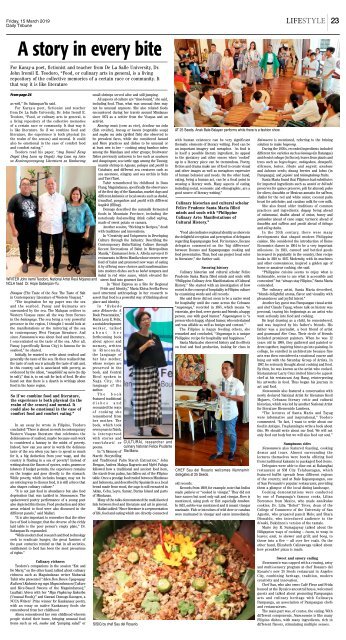15 MARCH 2019
Create successful ePaper yourself
Turn your PDF publications into a flip-book with our unique Google optimized e-Paper software.
Friday, <strong>15</strong> March <strong>2019</strong><br />
Daily Tribune<br />
LIFESTYLE 23<br />
A story in every bite<br />
For Karay-a poet, fictionist and teacher from De La Salle University, Dr.<br />
John Iremil E. Teodoro, “Food, or culinary arts in general, is a living<br />
repository of the collective memories of a certain race or community. It<br />
that way it is like literature<br />
From page 24<br />
as well,” Dr. Sabanpan-Yu said.<br />
For Karay-a poet, fictionist and teacher<br />
from De La Salle University, Dr. John Iremil E.<br />
Teodoro, “Food, or culinary arts in general, is<br />
a living repository of the collective memories<br />
of a certain race or community. It that way it<br />
is like literature. So if we combine food and<br />
literature, the experience is both physical (in<br />
the realm of the senses) and mental. It could<br />
also be emotional in the case of comfort food<br />
and comfort eating.”<br />
Teodoro read his paper, “Ang Damil Kang<br />
Dagat (Ang Lasa ng Dagat): Ang Lasa ng Asin<br />
sa Kontemporanyong Literatura sa Kanlurang<br />
Writer John Iremil Teodoro, National Artist Resil Mojares and<br />
NCLA head Dr. Hope Sabanpan-Yu.<br />
Bisayas (The Taste of the Sea: The Taste of Salt<br />
in Contemporary Literature of Western Visayas).”<br />
“The inspiration for my paper was the sea<br />
and the seafood. Panay and Guimaras are<br />
surrounded by the sea. The Malayan settlers in<br />
Western Visayas came all the way from Borneo<br />
in the balangays. The sea being a very powerful<br />
presence in the region, I thought I would look at<br />
the manifestations or the mirroring of the sea<br />
in contemporary West Visayan literature. And<br />
since Namnamin was about food and literature,<br />
I concentrated on the taste of the sea. After all,<br />
Panay (specifically Roxas City) is famous for its<br />
seafood,” he shared.<br />
Initially, he wanted to write about seafood and<br />
generally the taste of the sea. He then realized that<br />
the taste of such sea is actually the taste of salt and,<br />
in this country, salt is associated with poverty, as<br />
evidenced by the idiom, “magdildil ng asin (to dip<br />
in salt),” that is, to eat salt for lack of food. He also<br />
found out that there is a dearth in writings about<br />
food in his home region.<br />
So if we combine food and literature,<br />
the experience is both physical (in the<br />
realm of the senses) and mental. It<br />
could also be emotional in the case of<br />
comfort food and comfort eating.”<br />
In an essay he wrote in Filipino, Teodoro<br />
concluded: “There is almost no work in contemporary<br />
Western Visayan literature that celebrates the<br />
deliciousness of seafood, maybe because such work<br />
is considered a fantasy in the midst of poverty.<br />
Indeed, how can you savor in words the delicious<br />
taste of the sea when you have to spend so much<br />
for it, a big deduction from your wage, and the<br />
country is floating in a sea of poverty? Instead of<br />
writing about the flavors of oysters, crabs, prawns or<br />
lobsters if budget permits, the experience remains<br />
on the tongue and goes directly to the stomach.<br />
While poverty, which includes hunger, may not be<br />
an enticing way to discuss food, it is still a force that<br />
also shapes culinary culture.”<br />
“It is not just food in abundance but also food<br />
deprivation that was tackled in Namnamin. The<br />
spoken-word poetry performance of a young poet<br />
also depicted this theme. Food production and other<br />
areas related to food were also discussed in the<br />
different panels,” said Mallari.<br />
“It is also important to remember that the other<br />
face of food is hunger, that the obverse of the richly<br />
laid table is the poor person’s empty plate,” Dr.<br />
Sabanpan-Yu expounded.<br />
“While modern food research and food technology<br />
seek to eradicate hunger, the great famines of<br />
the past centuries remind us that in all societies,<br />
entitlement to food has been the most precarious<br />
of rights.”<br />
Culinary richness<br />
Teodoro’s companions in the session “Eat and<br />
Be Merry,” on the other hand, talked about culinary<br />
richness such as Maguindanao writer Mubarak<br />
Tahir who presented “Aden Bon Besen Uyag-uyag:<br />
Kultura’t Kakanin ng mga Maguindanaon (Culture<br />
and Rice-Based Sweets of the Maguindanao);”<br />
Lualhati Abreu with her “Mga Pagkaing Kakaiba<br />
(Unusual Foods);” and Gawani Domogo-Gaongen, a<br />
NCCA Writers’ Prize winner for Kankanaey poetry,<br />
with an essay on native Kankanaey foods she<br />
remembered from her childhood.<br />
Abreu remembered her own childhood wherein<br />
people visited their home, bringing unusual food<br />
items such as eel, suahe and “jumping salad” or<br />
small shrimps served alive and still jumping.<br />
All aspects of culture are “time-bound,” she said,<br />
including food. Thus, what was unusual then may<br />
not be unusual anymore. She also related foods<br />
encountered during her travels around Mindanao<br />
since 1974 as a settler from the Visayas and an<br />
activist.<br />
Kaning mais (corn as rice), kinilaw na isda<br />
(fish ceviche), law-uy or laswa (vegetable soup)<br />
and sugba na isda (grilled fish) she observed to<br />
be prevalent fares, while she considered lumad<br />
and Moro practices and dishes to be unusual or<br />
at least new to her — cooking using bamboo tubes<br />
among the Mandaya and other groups; freshwater<br />
fishes previously unknown to her such as sautnon<br />
and daupingan; sea turtle eggs among the Tausug;<br />
mantis shrimp in Agusan; palapa and pastil in<br />
Cotabato; and different sea creatures such as<br />
sea anemone, stingray and sea urchin in Sulu<br />
and Tawi-Tawi.<br />
Tahir remembered his childhood in Datu<br />
Piang, Maguindanao, specifically the observance<br />
of the first day of the Ramadan, market days and<br />
different kakanin or local sweets such as dudul,<br />
tinadtad, panyalam and pastil with different<br />
kagikit (filling).<br />
Domogo described the naturally fermented<br />
foods in Mountain Province, including the<br />
notoriously foul-smelling drink called safeng,<br />
made of sweet potato or cassava.<br />
Another session, “Sticking to Recipes,” dealt<br />
with traditions and innovations.<br />
In “Creativity and Uniqueness in Developing<br />
Culture through the Industry: Describing the<br />
Contemporary Balut-Eating Culture through<br />
Recent Recreations of Balut in Metropolitan<br />
Manila,” Emmanuel Jeric A. Albela surveyed <strong>15</strong><br />
restaurants in Metro Manila whose owners were<br />
fond of balut and promoted new ways of eating<br />
it by offering more choices and transformations<br />
into modern dishes such as balut tempura and<br />
balut in red wine sauce, which elevated the<br />
street food into gourmet fare.<br />
In “Bicol Express as a Site for Regional<br />
Pride and Identity,” Maria Eloisa Sevilla-Perez<br />
used structural anthropology in her research to<br />
assert that food is a powerful way of thinking about<br />
place and identity.<br />
In “Rekado<br />
asin Rekwerdo: A<br />
Book Presentation,”<br />
Maria Leny E. Felix,<br />
a social development<br />
worker, talked<br />
about her<br />
forthcoming book<br />
about spices and<br />
memory, written<br />
in Rinconada,<br />
the language of<br />
her late mother,<br />
whose recipes are<br />
preserved in the<br />
book, and Central<br />
Bicol spoken in<br />
Naga City, the<br />
language of the<br />
author.<br />
The book<br />
featured traditional<br />
dishes and<br />
recounted the ways<br />
of cooking she<br />
remembered from<br />
her mother. The<br />
book, which took<br />
seven years to finish,<br />
is interspersed<br />
with stories and<br />
rawitdawit or<br />
poems.<br />
In “A Memory of<br />
Starch: Storytelling<br />
and Traditional Palm Starch Extraction,” John<br />
Bengan, Andrea Malaya Ragrario and Myfel Paluga<br />
followed how a traditional and ancient food item,<br />
the starch from palms, has fallen out of the Filipino<br />
table. Once a prestige food traded between Mindanao<br />
and Indonesia, and described by Spaniards as a local<br />
bread made from wood, the sago is still extracted in<br />
Aklan, Cebu, Leyte, Samar, Burias Island and parts<br />
of Mindanao.<br />
Many of the talks demonstrated the multi-faceted<br />
link between food and literature and art in general.<br />
Mallari added: “Since literature is a representation<br />
of life, food and eating which are directly connected<br />
SISIG by chef Sau del Rosario.<br />
Cultural researcher and<br />
culinary historian Felice Prudente<br />
Sta Maria.<br />
At 25 Seeds, Anak Bale-Balayan performs while there is a fashion show.<br />
with human existence can be very significant<br />
thematic elements of literary writing. Food can be<br />
an important imagery and metaphor. As food is<br />
in itself a possible literary ingredient, its appeal<br />
to the gustatory and other senses when ‘cooked’<br />
up in a literary piece can be tremendous. Poetry,<br />
fiction and drama make use of food to create visual<br />
and other images as well as metaphors expressive<br />
of human behavior and needs. On the other hand,<br />
eating, being a human act, can be a focal point in<br />
weaving a literary work. Many aspects of eating,<br />
including social, economic and ethnographic, are a<br />
good source of literary writing.”<br />
Culinary historian and cultural scholar<br />
Felice Prudente Santa Maria filled<br />
minds and souls with “Philippine<br />
Culinary Arts: Manifestations of<br />
Cultural History.”<br />
“Food also indicates regional identity as shown in<br />
the delightful reception and perception of delegates<br />
regarding Kapampangan food. For instance, Ilocano<br />
delegates commented on the ‘big difference’<br />
between Ilocano and Kapampangan cooking and<br />
food presentation. Thus, food can project local color<br />
in literature,” she further said.<br />
Savoring history<br />
Culinary historian and cultural scholar Felice<br />
Prudente Santa Maria filled minds and souls with<br />
“Philippine Culinary Arts: Manifestations of Cultural<br />
History.” She started with an investigation of how<br />
rooted is the concept of hospitality in Filipino culture<br />
by examining words and old records.<br />
She said there did not seem to be a native word<br />
for hospitality until she came across the Cebuano<br />
“nayanaya,” recorded in 1885, which means “to<br />
entertain, give food, serve guests and friends; a happy<br />
person, one with good humor.” Nayanayaon is “a<br />
person who is happy, of good humor, who entertained<br />
and was affable as well as benign and content.”<br />
The Filipino is happy feeding others, she<br />
remarked and concluded, “Nayanaya is a unique<br />
Philippine recipe for hospitality and happiness.”<br />
Santa Maria also observed history and its effects<br />
on food and food production, looking for clues in<br />
Chef Sau del Rosario welcomes Namnamin<br />
delegates at 25 Seeds.<br />
old records.<br />
Records from 1609, for example, note that Indios<br />
made paksiw or “cooked in vinegar.” They did not<br />
have sauces but used only salt and vinegar. Boro is<br />
mentioned, using pork or fish especially tamban.<br />
In 1613, adobo was mentioned and it meant vinegar<br />
marinade. Fish or intestines of wild deer or carabao<br />
were marinated in vinegar and eaten immediately.<br />
Salmuera is mentioned, referring to the brining<br />
solution to make bagoong.<br />
During the 1830s, recorded ingredients included<br />
different rice varieties such as lamuyo (in Batangas)<br />
and bontot cabayo (in Ilocos); leaves from plants and<br />
trees such as boyoc-boyoc, cadayohan, dampalit,<br />
diliman, halon, libato and sagnit; anahaw<br />
and talanas seeds; dauag berries and lobas (in<br />
Pampanga); and pipisic and talangtalang fruits.<br />
Santa Maria found that Filipinos had substitutes<br />
for imported ingredients such as santol or bilimbi<br />
preserves for quince preserve; pili for almond; paho<br />
for olives; kasubha or Mexican annatto for saffron;<br />
shallot for the red and white onion; coconut palm<br />
heart for artichoke; and carabao milk for cow milk.<br />
She also found older traditions of common<br />
practices and ingredients: dayap being ahead<br />
of calamansi, shallot ahead of onion, honey and<br />
pakaskas ahead of cane sugar, turmeric ahead of<br />
kasubha and saffron and pasiti ahead of labuyo<br />
and siling haba.<br />
In the 20th century, there were many<br />
developments that shaped modern Philippine<br />
cuisine. She considered the introduction of Home<br />
Economics classes in 1904 to be a very important<br />
milestone. In 1913, canned and bottled goods<br />
increased in popularity in the country, then recipe<br />
books in 1918 to 1937. Modernity, with its machines<br />
and other conveniences, inspired a golden age of<br />
home or amateur cooking, she said.<br />
“Philippine cuisine seems to enjoy what is<br />
fashionable, seems to use what is accessible and<br />
convenient” but “always stay Filipino,” Santa Maria<br />
contended.<br />
The culinary artist, Santa Maria described,<br />
“blends delightful aroma, flavor and visuality with<br />
pleasantness and joyful intent.”<br />
Another key guest was Pampangan visual artist<br />
and chef Claude Tayag, whose talk on history was<br />
personal, tracing his beginnings as an artist who<br />
went seriously into food and cooking.<br />
He kept drawing as a child, he remembered,<br />
and was inspired by his father’s friends. His<br />
father was a journalist, a best friend of artist<br />
and gourmand Abe Cruz. Their circle of friends<br />
included prominent painters. When he was 12<br />
years old in 1968, they gathered and painted or<br />
drew together, inspiring him to go into painting. In<br />
college, he enrolled in architecture because fine<br />
arts was then considered a vocational course and<br />
hung out with the Saturday Group of Artists. In<br />
1987, he seriously thought about cooking and food.<br />
By then, he was known as the artist who cooked.<br />
Restaurateur Larry Cruz invited him to be a guest<br />
chef at his restaurant Ang Hang, reinterpreting<br />
his artworks in food. Thus began his journey in<br />
art and food.<br />
Namnamin also featured a conversation with<br />
newly declared National Artist for literature Resil<br />
Mojares, Cebuano literary critic and cultural<br />
historian, which was led by another National Artist<br />
for literature Bienvenido Lumbera.<br />
“The lectures of Santa Maria and Tayag<br />
were informative and inspirational,” Teodoro<br />
commented. “In fact, I want to write about our<br />
food in Antique. I’m planning to write a book about<br />
this. We should write about our food. We will not<br />
only feed our body but we will also feed our soul.”<br />
Sumptuous sides<br />
Namnamin also featured feasting, cooking<br />
demos and tours. Almost surrounding the<br />
lectures themselves were booths offering food<br />
from traditional kakanin to packaged food items.<br />
Delegates were able to dine out at Balanghai<br />
restaurant at SM City Telabastagan, which<br />
featured buffet spreads from different regions<br />
of the country; and at Bale Kapampangan, one<br />
of San Fernando’s popular restaurants, providing<br />
them a glimpse of the local dining landscape.<br />
Cooking demonstrations were conducted<br />
by one of Pampanga’s famous cooks, Lilian<br />
Borromeo from Mexico, who made sanikulas<br />
cookies; Dr. Lilia “Bebot” Teves, dean of the<br />
College of Commerce of the University of San<br />
Agustin, who prepared pancit Molo; and Shara<br />
Dionaldo, who introduced audience to the<br />
binaki, Bukidnon’s version of the tamale.<br />
Marie Joy R. Sumagaysay talked about the<br />
Hiligaynon ways of cooking — tuom, to wrap in<br />
leaves; asal, to skewer and grill; and boog, to<br />
throw into a fire — all over live coals. On the<br />
other hand, Elizabeth Calinawaga talked about<br />
how pinakbet pizza is made.<br />
Sweet and savory ending<br />
Namnamin was capped with a rousing, artsy<br />
and multi-sensory program at chef Rosauro del<br />
Rosario’s new 25 Seeds restaurant in Angeles<br />
City, combining heritage, tradition, modern<br />
creativity and innovation.<br />
Chef Sau, who also owns Café Fleur and Frida<br />
housed at the Dycaico ancestral house, welcomed<br />
guests and talked about promoting Pampangan<br />
arts and culinary heritage with Culinarya<br />
Pampanga, an association of Pampangan chefs<br />
and restaurateurs.<br />
The main part was, of course, the eating. With<br />
different components, Namnamin is like many<br />
Filipino dishes, with many ingredients, rich in<br />
different flavors, stimulating multiple senses.


















